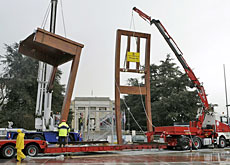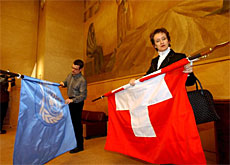Storm breaks over human rights memorial

A spat over a simple plaque is threatening to overshadow next week's inauguration by the Swiss president of the revamped esplanade opposite the United Nations in Geneva.
The memorial honours French diplomat René Cassin as the “architect” of the Universal Declaration of Human Rights but ignores the leading role played by Eleanor Roosevelt and others.
This omission has sparked consternation among human rights campaigners who are furious at what they see as a slight to Roosevelt’s legacy.
Roosevelt, the wife of United States president Franklin, was chairman of the first UN Human Rights Commission – created in 1946 – and headed the committee that drafted the declaration.
The UN General Assembly finally adopted the document, which sets out fundamental human rights, in December 1948.
Among those angered by the decision to erect a plaque solely dedicated to Cassin is the UN special rapporteur on the Right to Food, Switzerland’s Jean Ziegler.
He told swissinfo that the move was “stupid, historically wrong and a violation of gender equality”. Ziegler said the city council had two choices: either scrap the Cassin plaque or erect another for Eleanor Roosevelt.
He has raised the issue with the Swiss president and foreign minister Micheline Calmy-Rey, an ardent defender of human rights, who is due to speak at the inauguration ceremony on March 29.
Foreign ministry spokesman Jean-Philippe Jeannerat declined to comment on the controversy but said Calmy-Rey would “express her views” at the inauguration.
“Grievous oversight”
Opposition has been mobilised by Anne Herdt, a human rights campaigner, who describes the omission of Roosevelt as a “grievous oversight”.
She has written to the city council, the Swiss president, former US diplomats and the UN High Commissioner for Human Rights among others.
“This plaque will remove from public consciousness everyone else who contributed to [the declaration],” she said. “We don’t wish to devalue René Cassin but he was not the only author”.
“At this time when many question the universality of the declaration, claiming that it does not apply to them or to their culture, it is extremely unfortunate to have one plaque citing one Western man as the author… right before the gates of the United Nations. It underlines these suspicions,” added Herdt.
George Gordon-Lennox, who represents the non-governmental organisation Reporters without Borders at the UN, said that while there was no doubt Cassin had played a vital role, his contribution was not unique.
“Unfortunately tourists visiting the Place des Nations will think he was the only person involved in the Universal Declaration of Human Rights. He was a great man – no one is saying the contrary – but others need to be recognised,” he said.
Plaque
In a letter to Herdt earlier this month, Christian Ferrazino, head of planning at the city council, explained that the Paris-based René Cassin Foundation had approached the Geneva authorities last year requesting a plaque in his honour
He stressed that the plaque was purely a memorial to Cassin and was in no way a commemoration of the declaration for which sole rights were being bestowed on the Frenchman.
Acknowledging the lack of women role models in today’s “patriarchal society”, Ferrazino said the city council was open to the idea of a similar memorial for Roosevelt either on the Place des Nations or elsewhere in Geneva. He added that he would highlight her contribution at the inauguration ceremony.
Informed of the controversy by swissinfo, Maxime Joinville-Ennezat, president of the René Cassin Foundation, said critics had simply got it wrong. He insisted that Cassin was responsible for the initial draft and was the “driving force” behind the declaration.
“There were many leaders on the project but Cassin was at the forefront,” said Joinville-Ennezat. “He achieved the impossible so that all the delegations voted in favour of the Universal Declaration of Human Rights.”
swissinfo, Adam Beaumont in Geneva
According to the UN, its own secretariat under the guidance of John Humphrey drafted the blueprint to serve as the basic working paper of the drafting committee headed by Eleanor Roosevelt.
The drafting committee comprised eight people, from Australia, Chile, China, France, Lebanon, the Union of Soviet Socialist Republics, Britain and the United States.
Since 1948 the declaration has been translated into more than 300 languages. Next year marks the 60th anniversary of what has been dubbed a “Magna Carta for all humanity”.
René Cassin, a French diplomat and jurist, received the Nobel peace prize in 1968 for his role in drafting the declaration.
In his acceptance speech, Cassin makes specific reference to Roosevelt presiding over the development of the document.
Cassin served as French delegate to the League of Nations in Geneva from 1924 to 1938 and was a French representative to the UN from 1946-1968.
The wife of Franklin D Roosevelt was one of the most active and influential First Ladies in the history of the White House.
After the death of her husband in 1945, she was appointed by President Truman to the US delegation to the UN General Assembly – a position she held until 1953.
She was chairman of the UN Human Rights Commission from 1946-1951.

In compliance with the JTI standards
More: SWI swissinfo.ch certified by the Journalism Trust Initiative

You can find an overview of ongoing debates with our journalists here. Please join us!
If you want to start a conversation about a topic raised in this article or want to report factual errors, email us at english@swissinfo.ch.